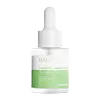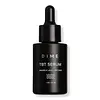What's inside
What's inside
 Key Ingredients
Key Ingredients

 Benefits
Benefits

 Concerns
Concerns

No concerns
 Ingredients Side-by-side
Ingredients Side-by-side

Water
Skin ConditioningBetaine
HumectantDicaprylyl Carbonate
EmollientMethyl Gluceth-20
HumectantNeopentyl Glycol Diheptanoate
EmollientNiacinamide
SmoothingPropanediol
SolventGlycerin
HumectantEthoxydiglycol
HumectantZinc PCA
HumectantPhenoxyethanol
PreservativeButylene Glycol
HumectantBakuchiol
AntimicrobialHelianthus Annuus Seed Oil
EmollientHydroxyethyl Acrylate/Sodium Acryloyldimethyl Taurate Copolymer
Emulsion StabilisingCarbomer
Emulsion StabilisingAllantoin
Skin ConditioningEthylhexylglycerin
Skin ConditioningDisodium EDTA
Inositol
HumectantTocopheryl Acetate
AntioxidantTriethanolamine
BufferingSodium Hyaluronate
HumectantPolysorbate 20
EmulsifyingPalmitoyl Tripeptide-1
Skin ConditioningPalmitoyl Tetrapeptide-7
Skin ConditioningWater, Betaine, Dicaprylyl Carbonate, Methyl Gluceth-20, Neopentyl Glycol Diheptanoate, Niacinamide, Propanediol, Glycerin, Ethoxydiglycol, Zinc PCA, Phenoxyethanol, Butylene Glycol, Bakuchiol, Helianthus Annuus Seed Oil, Hydroxyethyl Acrylate/Sodium Acryloyldimethyl Taurate Copolymer, Carbomer, Allantoin, Ethylhexylglycerin, Disodium EDTA, Inositol, Tocopheryl Acetate, Triethanolamine, Sodium Hyaluronate, Polysorbate 20, Palmitoyl Tripeptide-1, Palmitoyl Tetrapeptide-7
Water
Skin ConditioningMandelic Acid
AntimicrobialPropanediol
SolventNiacinamide
SmoothingSodium Hyaluronate
HumectantCamellia Sinensis Extract
AntioxidantVitis Vinifera Seed Extract
AntimicrobialPhenoxyethanol
PreservativeEthylhexylglycerin
Skin ConditioningRosa Canina Seed Oil
EmollientNopalea Cochenillifera Extract
Skin ConditioningPunica Granatum Seed Oil
EmollientHelianthus Annuus Seed Oil
EmollientPersea Gratissima Oil
Skin ConditioningSclerocarya Birrea Seed Oil
HumectantVaccinium Vitis-Idaea Seed Oil
AntioxidantMoringa Oleifera Seed Oil
EmollientBakuchiol
AntimicrobialNigella Sativa Seed Oil
EmollientResveratrol
AntioxidantGynostemma Pentaphyllum Leaf/Stem Extract
AntioxidantLycium Barbarum Fruit Extract
AstringentPalmitoyl Tetrapeptide-10
Skin ConditioningPalmitoyl Tetrapeptide-7
Skin ConditioningAzadirachta Indica Seed Oil
Skin ConditioningWater, Mandelic Acid, Propanediol, Niacinamide, Sodium Hyaluronate, Camellia Sinensis Extract, Vitis Vinifera Seed Extract, Phenoxyethanol, Ethylhexylglycerin, Rosa Canina Seed Oil, Nopalea Cochenillifera Extract, Punica Granatum Seed Oil, Helianthus Annuus Seed Oil, Persea Gratissima Oil, Sclerocarya Birrea Seed Oil, Vaccinium Vitis-Idaea Seed Oil, Moringa Oleifera Seed Oil, Bakuchiol, Nigella Sativa Seed Oil, Resveratrol, Gynostemma Pentaphyllum Leaf/Stem Extract, Lycium Barbarum Fruit Extract, Palmitoyl Tetrapeptide-10, Palmitoyl Tetrapeptide-7, Azadirachta Indica Seed Oil
Ingredients Explained
These ingredients are found in both products.
Ingredients higher up in an ingredient list are typically present in a larger amount.
Bakuchiol is a plant-derived antioxidant (it's vegan!). It is often called the replacement for retinol although it is not part of the same family.
It has similar effects as retinol: skin smoothing, reducing discoloration, and preventing wrinkles. It does not cause as much irritation as traditional retinoids.
Bakuchiol works by breaking down free radicals and stimulating collagen production in skin.
Combining bakuchiol with retinol will not have adverse side effects. Studies show using them will just boost the benefits. Bakuchiol is also found to help stabilize retinol.
While bakuchiol does not make the skin more sun sensitive, we recommend wearing SPF on a daily basis.
Read more about traditional retinol
Learn more about BakuchiolEthylhexylglycerin (we can't pronounce this either) is commonly used as a preservative and skin softener. It is derived from glyceryl.
You might see Ethylhexylglycerin often paired with other preservatives such as phenoxyethanol. Ethylhexylglycerin has been found to increase the effectiveness of these other preservatives.
Helianthus Annuus Seed Oil is the oil derived from the seeds of a Sunflower. Sunflower seed oil is non-fragrant. It is an emollient, meaning it helps to soften the skin.
Sunflower seed oil contains many fatty acids. The fatty acids found in sunflower seeds include (from highest amount to least): linoleic acid, myristic acid, palmitic acid, stearic acid, arachidic acid, oleic acid, and linolenic acid.
These fatty acids help the skin create ceramides. Ceramides play a role in repairing the skin barrier.
Helianthus Annuus Seed Oil helps moisturize the skin. This in turn helps the skin look more rejuvenated and smoother.
Sunflowers are rich in vitamin E.
Historians believe Indigenous cultures of North America domesticated sunflowers before corn. Thus they relied on sunflower oil for a variety of uses. One such use is moisturizing skin and hair.
Sunflower seed oil may not be fungal acne safe. We recommend speaking with a professional if you have any concerns.
Learn more about Helianthus Annuus Seed OilNiacinamide is a multitasking form of vitamin B3 that strengthens the skin barrier, reduces pores and dark spots, regulates oil, and improves signs of aging.
And the best part? It's gentle and well-tolerated by most skin types, including sensitive and reactive skin.
You might have heard of "niacin flush", or the reddening of skin that causes itchiness. Niacinamide has not been found to cause this.
In very rare cases, some individuals may not be able to tolerate niacinamide at all or experience an allergic reaction to it.
If you are experiencing flaking, irritation, and dryness with this ingredient, be sure to double check all your products as this ingredient can be found in all categories of skincare.
When incorporating niacinamide into your routine, look out for concentration amounts. Typically, 5% niacinamide provides benefits such as fading dark spots. However, if you have sensitive skin, it is better to begin with a smaller concentration.
When you apply niacinamide to your skin, your body converts it into nicotinamide adenine dinucleotide (NAD). NAD is an essential coenzyme that is already found in your cells as "fuel" and powers countless biological processes.
In your skin, NAD helps repair cell damage, produce new healthy cells, support collagen production, strengthen the skin barrier, and fight environmental stressors (like UV and pollution).
Our natural NAD levels start to decline with age, leading to slower skin repair, visible aging, and a weaker skin barrier. By providing your skin niacinamide, you're recharging your skin's NAD levels. This leads to stronger, healthier, and younger looking skin.
Another name for vitamin B3 is nicotinamide. This vitamin is water-soluble and our bodies don't store it. We obtain Vitamin B3 from either food or skincare. Meat, fish, wheat, yeast, and leafy greens contain vitamin B3.
The type of niacinamide used in skincare is synthetically created.
Learn more about NiacinamidePalmitoyl Tetrapeptide-7 (formerly Palmitoyl Tetrapeptide-3) is a lab-made peptide with anti-inflammatory and skin-repairing benefits. It's made up of four amino acids (glycine, glutamine, proline, and arginine) and palmitic acid (which helps it penetrate skin more effectively).
This ingredient helps reduce inflammation by limiting the production of interleukin-6 (IL-6), a chemical that triggers inflammatory responses, particularly after UV exposure.
Less inflammation = slower collagen breakdown and a longer-lasting, youthful appearance.
Palmitoyl Tetrapeptide-7 also stimulates collagen production and supports a healthier skin barrier.
Over time, this can improve skin firmness, hydration, and reduce the appearance of fine lines. It’s commonly paired with Palmitoyl Tripeptide-1 in the well-known Matrixyl 3000 complex for enhanced anti-aging effects.
This ingredient has been shown to be effective and safe in cosmetic use and you'll typically find it in small amounts (less than 0.01%).
Due to its palmitic acid base, it may not be safe for Malassezia folliculitis.
Read more about other common types of peptides here:
Learn more about Palmitoyl Tetrapeptide-7Phenoxyethanol is a preservative that has germicide, antimicrobial, and aromatic properties. Studies show that phenoxyethanol can prevent microbial growth. By itself, it has a scent that is similar to that of a rose.
It's often used in formulations along with Caprylyl Glycol to preserve the shelf life of products.
Propanediol is an all-star ingredient. It softens, hydrates, and smooths the skin.
It’s often used to:
Propanediol is not likely to cause sensitivity and considered safe to use. It is derived from corn or petroleum with a clear color and no scent.
Learn more about PropanediolSodium Hyaluronate is hyaluronic acid's salt form. It is commonly derived from the sodium salt of hyaluronic acid.
Like hyaluronic acid, it is great at holding water and acts as a humectant. This makes it a great skin hydrating ingredient.
Sodium Hyaluronate is naturally occurring in our bodies and is mostly found in eye fluid and joints.
These are some other common types of Hyaluronic Acid:
Learn more about Sodium HyaluronateWater. It's the most common cosmetic ingredient of all. You'll usually see it at the top of ingredient lists, meaning that it makes up the largest part of the product.
So why is it so popular? Water most often acts as a solvent - this means that it helps dissolve other ingredients into the formulation.
You'll also recognize water as that liquid we all need to stay alive. If you see this, drink a glass of water. Stay hydrated!
Learn more about Water